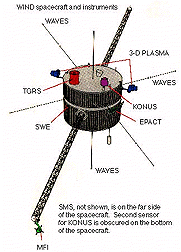|
-------------------------- ------------------- |
 Satellites which study their local environment usually do so for some scientific purpose.
The earliest ones, like Explorer-1 and Explorer-3 which discovered the radiation belts and Explorer 12. which crossed the boundary of the Earth's magnetosphere.
Satellites which study their local environment usually do so for some scientific purpose.
The earliest ones, like Explorer-1 and Explorer-3 which discovered the radiation belts and Explorer 12. which crossed the boundary of the Earth's magnetosphere.
Some of these move in circular orbits, relatively close to Earth--for instance, FAST which analyzed the intricate structure of electric currents, particles and fields in the curtains of the polar aurora, and MAGSAT which in 1979-80 orbited just above the atmosphere and mapped the Earth magnetic field with great precision. A follow-up magnetic survey started in 1999 with the Danish "Oersted" satellite. Many "down-looking" satellites also carry out local observations. Perhaps the most interesting satellites in this group are the ones sent into distant orbits, some of them extending well past the Moon--e.g. the WIND spacecraft pictured here. Among them is a long series of IMPs (Interplanetary Monitoring Platforms) which sampled the Earth's distant magnetic environment, the magnetosphere, and the surrounding interplanetary region. Other explorers of the distant magnetosphere have included the three ISEE spacecraft (International Sun-Earth Explorers), Polar in an elliptical polar orbit with cameras observing the polar aurora, and Image observing energetic neutral atoms. It also includes the European HEOS 1 and 2, Russia's Prognoz series and Interball, and Japan's Akebono, Jikiken and Geotail. In the recent era, many satellites probing the Earth's space environment were launched as coordinated groups, such as the 4 spacecraft of the European "Cluster II" mission (2001) and the more recent "Magnetospheric Multiscale Mission (MMS)" (2015). Other "teamed" missions have included ISEE, DE (Dynamics Explorer) and Themis. A special class of satellites exploring the Earth's environment are those posted near the Lagrangian point L1 about 236 Earth radii sunward of Earth, an equilibrium point at which an object co-orbits with Earth. These satellites act as "early warning outposts" intercepting fast plasma clouds from the Sun about 15-30 minutes before they hit Earth. They must have propulsion capabilities, because the equilibrium is unstable and anyway, tracking a spacecraft at the L1 point would require pointing the receiving antenna at the Sun. Such early warning is described in an earlier web page and is currently carried out by the ACE spacecraft. |